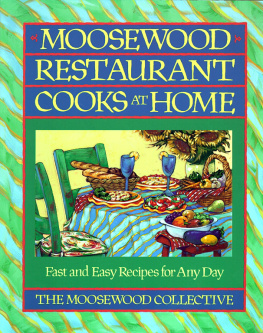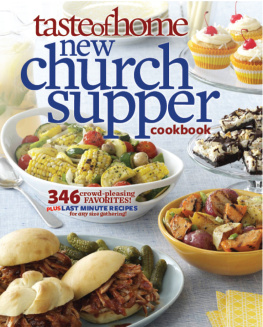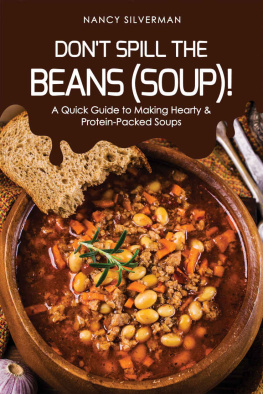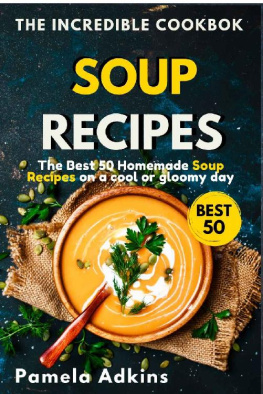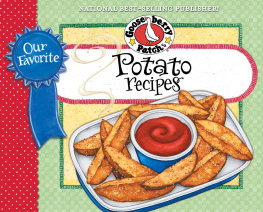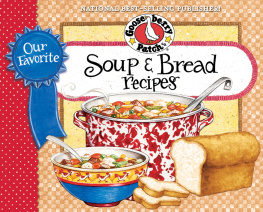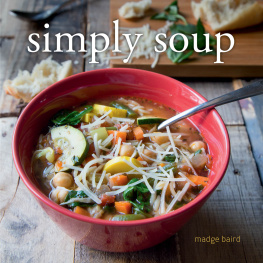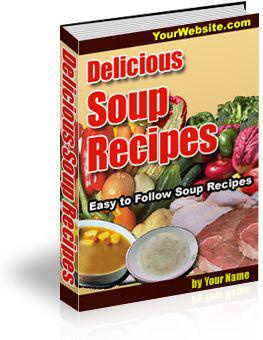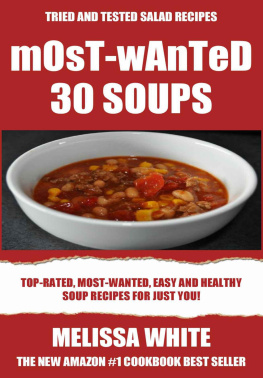Thank you for downloading this Touchstone eBook.
Join our mailing list and get updates on new releases, deals, bonus content and other great books from Touchstone and Simon & Schuster. C LICK H ERE T O S IGN U P or visit us online to sign up at
eBookNews.SimonandSchuster.com
Contents
This book is dedicated to our hardworking parents,
who somehow found the time.
A CKNOWLEDGMENTS
A s always, we give our fondest acknowledgments to our literary agents, Elise and Arnold Goodman, for their long-term encouragement and enduring support. The Moosewood Collective is grateful to Sydny Weinberg Miner, our enthusiastic editor, for her professionalism, leadership, and intelligent good humor. We praise Bonni Leon and Carol Haralson for their inspired artistry, impeccable craftwork, and constant patience.
We give well-deserved thanks to John E. Alexander, President of the CBORD Group, Inc., Ithaca, New York, for his generous assistance. He made his companys services available to us, to provide the nutritional analyses for this book. This is just one application out of hundreds provided by their software, which specializes in the management of food and nutrition services. The analyses were performed by CBORDs Department of Database Services, managed by Laura B. Winter, R.D., and assisted by Katherine Isacks.
We appreciate their expertise and guidance. Special thanks to Jude Tulla for getting us together.
Introduction
F rom the customers in Moosewood Restaurant, the students in our cooking classes, the readers of our previous cookbooks, our friends, and our own experiences, we know that most of us face two strong and seemingly contradictory needs: a longing for relaxed, interesting, and meaningful dining and the necessity of slapping dinner on the table in short order. Like everyone else, each of us at Moosewood juggles work, home, family, social life, and other interests. We hustle all day, trying to accomplish the things we must do, hoping to create a spare moment for what wed like to do, arranging our schedules to connect with the people wed like to do them with. However, we do have a certain edge at suppertime because we have learned to cook under fire at the restaurant.
Making a good dinner quickly at home on Tuesday is small potatoes compared to preparing entres on a busy Saturday night in Moosewoods small action-packed, pressure-cooker kitchen. Also, we are constantly sharing our ideas and experiences and combining and compiling our knowledge so that it can be of use to everyone. Eighteen heads are better than one for some tasks. But even with experience and numbers on our side, we havent been able to discover any single solution or magical technique for a workweek cuisine. Frankly, we dont think there is one. However (drumroll, please), we have been able to collectively figure out a lot of little solutions.
The combination of carefully honed and tested recipes, tasty ingredients, time-saving tricks, and planning suggestions can all add up to a delightful whole-foods cuisine that is quick and easy. There is empowerment and satisfaction in providing this basic need. You could buy the kids a so-so pizza for dinner and then complain about the price and wonder about the nutritional value. But you might realize that rather than saving time and energy, you actually spent a frazzled half hour arguing about how many video games 81), that your kitchen smelled wonderful, and that you somehow found the time to provide this gift? We usually consider it time well spent, even if a dinner entre requires 45 minutes to prepare (the longest time in this bookmost take 30 minutes or less). The hands-on preparation time is often much less than the total time. (You get an extra 15 or 20 minutes to play with the dog.) Spend 10 or 15 minutes after dinner or in the morning putting together a dish that needs to chill or that can be popped into the oven the next evening.
When you cant wait 30 or 40 minutes to eat, look for the many very quick last-minute recipes in this book. The truth is that the best reason to prepare meals faster is so that there is more time to spend lingering at the table, enjoying life. The food at Moosewood has always derived from an ethnic home-style traditionpeasant food, created by hardworking people who cooked for themselves using minimal equipment, fresh foods, and simple cooking methods. We have found many dishes among these classics that serve our own needs. Weve been careful not to sacrifice quality as weve sought out the fastest and most versatile dishes. Weve sometimes simplified traditional dishes by using fewer ingredients or have substituted ingredients that were more readily available or faster-cooking.
Often weve experimented with quicker or more healthful cooking methods. Weve researched and given our advice on some convenience products (there are some we can recommend), and weve provided plenty of other shopping tips. Youll find suggestions in this book for organizing your work, preparing food ahead of time, double-purpose cooking, and the creative use of leftovers. We indicate appropriate substitutions for ingredients and often give variations of a recipe, so that you can have more flexibility. We offer a host of menu-planning ideas that can save you a tremendous amount of time and effort. We discuss the aesthetics and logistics of combining dishes, and give a step-by-step walk-through of some sample menus.
Well show you how a well-stocked pantry can be your most valuable asset when you need to throw together a last-minute meal, and weve included shopping tips and information on storing food. All of this extra advice adds more text to the simple procedure for the recipe, so we arranged the information on the page to make each recipe easy to read and follow. Weve tested and retested the recipes, and we believe that our instructions will direct you toward maximum efficiency and minimum cleanup. At Moosewood we continue to place an ever greater importance on the healthful value of foods. The new USDA Food Guide Pyramid validates the health benefits of a low-fat vegetarian diet. The broad base of the pyramid is composed of a balance of grains, vegetables, and fruits with only the small tip formed by dairy foods, eggs, fish, fats, and sweets.
This rather accurately describes most of the worlds ancient starch-based ethnic cuisines, which have been our inspiration all along. We know that many of you are concerned with the nutritional aspect of cooking, so weve included a nutritional analysis at the end of each recipe. On 18, youll find more detailed information on the food pyramid, nutritional analysis, and some easy-to-use formulas for culinary computations, particularly for determining recommended percentages of dietary fat. Healthful eating has become a fashionable choice, and so the goals of a nutritious vegetarian diet and gourmet dining have drawn much closer. In many ways, maintaining a meatless diet is much easier now than it once seemed. For one thing, its no longer considered weird to eat this way.
Supermarkets are exploding with previously unfamiliar vegetables, exotic fruits, fresh herbs, and a large variety of recently rediscovered grains and beans. Its not hard to find whole-grain breads and good Italian pastas. Pestos and salsas, fresh mozzarella and goat cheeses, are no longer found only in gourmet or ethnic markets. All of this bounty is an inspiration to honor the fresh and simple. We admit that years ago we overcompensated for the lack of meat on the menu at Moosewood Restaurant by using cheese and other rich dairy products in almost every casserole, but no longer. Our tastes have evolved toward a simpler, lighter, and more vital style of food.
Next page
